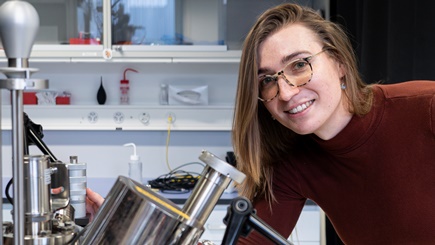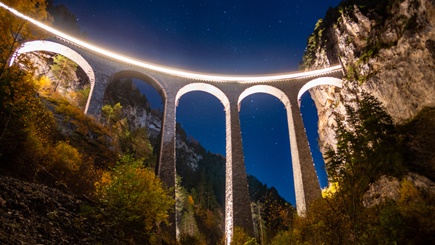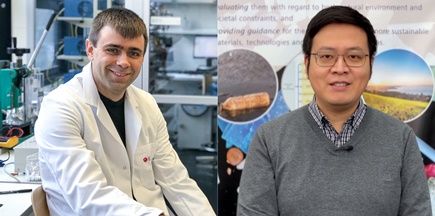In brief
News from the lab
Young 3R Investigator Award for Empa researcher
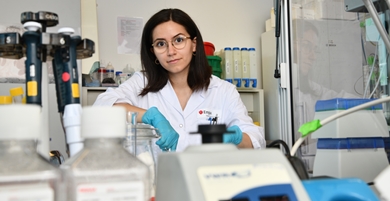
The Swiss 3R Competence Center (3RCC) has awarded Manon Murdeu, a doctoral student at Empa's Particles-Biology Interactions lab, the 3R Young Investigator Award. The young researcher has developed a placenta-embryo chip that can be used to assess the toxic effects of chemicals, drugs, and nanoparticles during pregnancy without the use of animal testing. Her work fills a major gap in health research: the lack of safety data on how substances affect pregnant women and developing embryos.
Children's book with ideas for a planet-friendly future
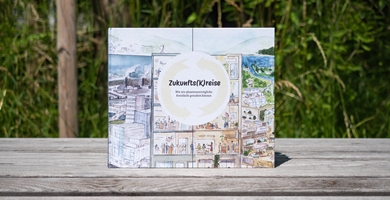
What could sustainable living look like for everyone? Together with schoolchildren and the University of Teacher Education St. Gallen (PHSG), Empa researchers have published an illustrated children's book on circular economy called “Zukunfts(K)reise” (Journeys into the Future), which aims to encourage reflection. It is aimed at children in grades 3 to 6 of primary school. The researchers at PHSG have developed comprehensive accompanying material for use in schools. The book is available as a free e-book and can be obtained as a high-quality printed edition from Empa and PHSG.
Swiss engineering “Oscar” for climate-saving concrete
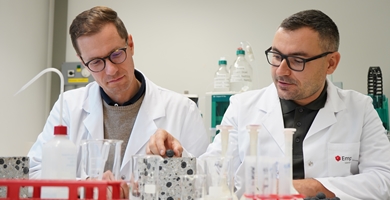
The Building Award recognizes outstanding engineering achievements in the Swiss construction industry – similar to the Oscars in the film world, it is awarded in several categories. This year, Empa was honored in the category Research, Development, Start-ups for its CO₂-storing concrete containing carbon pellets. Empa researchers Pietro Lura, Mateusz Wyrzykowski, Nikolajs Toropovs, Daniel Grossegger, and Frank Winnefeld from the Concrete and Asphalt lab developed the innovative concrete as a carbon sink – a promising approach to significantly reducing emissions in the construction industry.
Comprehensive “catalog” of chemicals of concern in plastics
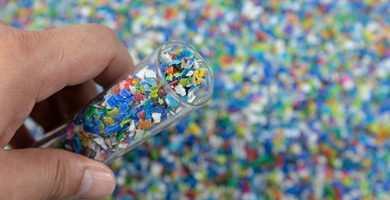
All plastics, from food packaging to car tires, contain hundreds of chemicals that can end up in food, living spaces, and the environment. A study published in the scientific journal Nature, with the participation of Empa and Eawag, provides the first comprehensive and systematic overview of all chemicals that may be contained in plastics, their properties, uses, and hazards. The study also offers a scientific approach to identifying chemicals of concern. This enables scientists and manufacturers to develop safer plastics and policy makers to promote a non-toxic circular economy.
Second quantum spin model from nanographene molecules
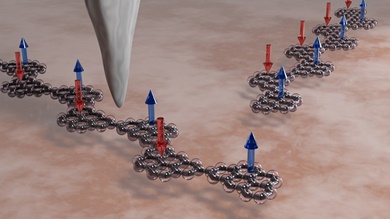
For the second time, Empa researchers from the nanotech@surfaces laboratory have experimentally recreated a fundamental theoretical model of quantum physics that goes back to Nobel laureate Werner Heisenberg. The basis for the successful experiment is a kind of “quantum Lego” made of tiny carbon molecules, so-called nanographenes. The second success makes it clear that this method enables versatile experimental research into quantum technologies, which could one day help them break into the mainstream.
CO₂ as a resource: Empa fellowship for Carlota Bozal-Ginesta
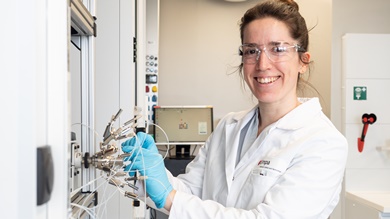
Empa researcher Carlota Bozal-Ginesta wants to make CO₂ more efficient to use. Using machine learning and high-throughput experiments, she is developing better electrodes for CO₂ electrolysis, a key technology for the production of synthetic fuels. The aim is to produce as few specific products as possible instead of complex mixtures. She was awarded a two-year Empa Young Scientist Fellowship for her innovative project.
Nanomaterials under tension
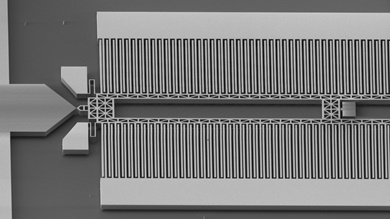
Researchers at Empa and ETH Zurich have developed an electromechanical system that selectively strains nanomaterials. This makes it possible to produce electronic components with novel properties, which hold promise for quantum computing, communication, sensor technology and energy conversion. A video of the moving system by Empa researcher Peter Lendway was awarded first place in the SNSF competition for scientific images in the category Videos.
Urs Leemann new Deputy Director of Empa
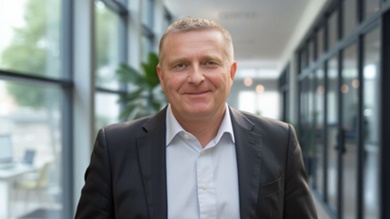
Urs Leemann was appointed Deputy Director of Empa at the beginning of April 2025. The Head of the Corporate Services department succeeds Peter Richner, who is retiring from the Directorate. Leemann brings a wealth of experience in research, business and start-ups and is also involved in the Cleantech Hub Dietikon Limmattal. Together with Director Tanja Zimmermann and Lorenz Herrmann, he will help shape Empa's strategic development.
Young researcher sheds light on quantum molecules
Empa researcher Eve Ammerman wants to bring quantum technologies one step closer to application by combining quantum effects with light. This should enable future quantum-based devices to communicate better with existing technologies.
Her research project is now being supported with a two-year Empa Young Scientist Fellowship. The physicist has been working in Empa's nanotech@surfaces laboratory led by Roman Fasel for the last two years.
Netto Zero in the Graubünden Rhine Valley
How can decarbonization be implemented cost-effectively in the Graubünden Rhine Valley? The canton of Graubünden, the energy suppliers and leading industrial companies in the Graubünden Rhine Valley have investigated this question together with Empa using innovative modeling techniques. The results confirm the assessments of the Economic Forum: Decarbonization is technically feasible and economically interesting. The Empa study provides concrete technical implementation steps and serves as a model example that can also be transferred to other regions.
Two Empa researchers honored as "influencers"
The Empa scientists Maksym Kovalenko and Zhanyun Wang are among the world's most frequently cited researchers in their fields. Their influential work has earned them a place on the list of "Highly Cited Researchers".
“Highly Cited Researchers” are researchers who have exerted a significant and far-reaching influence on their field of research in the last ten years through numerous highly cited publications. Every year, the analytics company Clarivate compiles a list of scientists whose publications have been most frequently cited. They are considered to be particularly influential in their fields. Only the authors of the one percent of the most highly cited scientific papers in various disciplines are awarded the title of "Highly Cited Researcher". This year, two Empa scientists are among the 6886 researchers featured on the list: Maksym Kovalenko and Zhanyun Wang.
Read more.
Award for innovation against surgical complications

The Empa Innovation Award recognizes outstanding projects bridging the gap between the laboratory and industry. This year, a team from Empa and ETH Zurich led by Alexander Jessernig, Alexandre Anthis and Inge Herrmann was honored for their SensAL technology. SensAL warns quickly and precisely of life-threatening complications after abdominal surgery. The principle is cost-effective, convincingly simple and easy to integrate into everyday clinical practice, which also impressed the jury. Shortly after the prize was awarded, SensAL was also honored at the Falling Walls Switzerland science event.
Falling Walls Science Breakthrough of the Year 2024 goes to Inge Herrmann

Empa researcher Inge Herrmann was awarded the Global Women's Impact Award and the Science Breakthrough of the Year 2024 in the Women's Impact category by the Falling Walls Foundation. Herrmann presented her research in November on the Falling Walls Main Stage and as part of the Kavli Dialog. In addition, Alexander Jessernig, a doctoral student in Herrmann's team and winner of Falling Walls Switzerland, presented his sensor for the early detection of post-operative bowel leaks. Inge Herrmann heads a research group in Empa's Particles-Biology Interactions laboratory and the Ingenuity Lab at the University of Zurich and Balgrist University Hospital. She is also an accredited professor in the Department of Mechanical Engineering at ETH Zurich. In one of her research projects, her team has developed a reversible hydrogel implant that could be used to prevent the widespread female disease endometriosis and at the same time act as contraceptive.
A look behind the scenes: Become a Friend of Empa

Empa wants to further expand its dialog with the interested public. To this end, it has launched a new initiative called Friends of Empa. The aim of the initiative is to create a community of people who are interested in Empa and its research. Friends have access to exclusive events, lectures and lab tours. In this way, they learn first-hand from the researchers what they are currently working on and get a look behind the scenes, which is hardly possible in normal circumstances. The community is open to everyone. Empa is looking forward to welcoming many Friends to its campuses in the coming years. Would you also like to be a Friend of Empa? Register at: https://www.empa.ch/web/friends/anmeldung
Empa Entrepreneur Fellowship for tomorrow's start-ups

Empa's promotion of its start-ups has received a boost through the Empa Entrepreneur Fellowship. 2024 marks the third time this fellowship was awarded to young researchers who want to turn applications-oriented research into innovative products or services. Three winners have been selected this year: Oscar Cipolato is pushing forward laser tissue soldering with robots, Federica Bellizio is developing a platform for energy suppliers, and David Häusermann is researching drones to help firefighters and industrial inspectors.
-
Share

